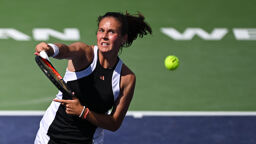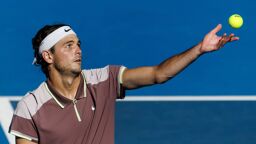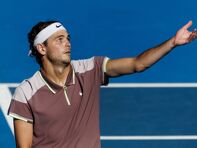Thursday is #NationalComingOutDay 🌈 and I’m encouraging all of you that work in tennis – as well as those who play, watch and love the sport too – to share your story (whatever that may be!) using #LGBTennis
— Nick McCarvel (@NickMcCarvel) October 10, 2018
Let’s continue to show how open, welcoming and loving 🎾 is! #NCOD pic.twitter.com/UsLyYb15HL
On a sunny summer Saturday in 1998 I sat in my parents’ basement, my eyes glued to the TV. There was my hero, Monica Seles, bashing the ball baseline-to-baseline against the player known as the Barcelona Bumblebee, Arantxa Sanchez Vicario.
I spent a lot of my summer days like this: In front of one of our TVs at my childhood home in Montana, watching endless hours of tennis. The only thing that got me more excited was what would come next: I went out and played tennis myself, in our alley, hitting against the smooth-surfaced wall of our neighbor’s barn. Yes, barn.
On National Coming Out Day some 20 years later, I have the chance to reflect on the sport that gave me so much and still does. I was a wide-eyed kid from a community of 30,000 in the Rockies who wanted to be on Centre Court at Wimbledon. And the sport made me that much more aware of the real world beyond my small-town existence.
I tell that story of 1998 (and the years to come beyond it) because of the intrinsic connection that I feel with the sport I so love, and the way that it impacted not only my childhood and career path, but also my ability to come out, to be comfortable with the person I was and am, and to stand for what I believed in rural America at the turn of the Millennium.
It wasn’t always easy to do.
Billie Jean King and Martina Navratilova were global tennis megastars by the time I was playing competitively myself, the two out lesbians who blazed so many trails for us all. Their celebrity made their sexuality feel like no big deal at a time in my life when my sexuality was the biggest deal, at least to me. Little did I know the major struggles that they had gone through in their own coming out processes years prior.
And here they were inspiring a little kid from the Big Sky state.
I was in eighth grade when 19-year-old Amélie Mauresmo made her shock run to the 1999 Australian Open final. She played lights out tennis, beating world No. 1 Lindsay Davenport en route. It was a series of unfortunate comments that caused – in part – Mauresmo to come out, but I read in the morning paper from afar and listened to the ESPN coverage of it all.
She was decidedly herself. And I loved her for it.
As many people with stories of their own can attest to, my challenges were great when I did decide to come out as gay to my siblings, friends, parents and then my greater community in the latter years of my teens. I left for college and a fresh start in Seattle with a comfort of knowing that many had come before me with their own stories of coming out. Tennis had instilled that in me.
I’ve been lucky enough to feel comfortable in coming out at school, in my young professional life and then as a tennis reporter and writer. Sure, it felt nerve-wracking at times, but I never really doubted it.
I’ve realized those childhood ambitions as a journalist, covering all four majors, three Olympics and making a career on the tennis tour. I have interviewed Billie Jean, Martina and Amelie. I have made it to the very Court Philippe Chatrier where I watched Monica on TV that summer day – even if it’s just in the press tribune at the side of the court.
In 2010, I had only been in New York for a couple years, and I interviewed Navratilova by phone for an article I was working on. I actually don’t remember what the piece was about, but I do remember stopping her after we were finished, and saying something like, “Martina, I’m a young gay journalist, and I just want to thank you for all you stand for. I appreciate it.”
She was more than gracious. “Call me anytime,” she replied. I don’t think she really meant it, but I did save that number in my phone – even if in the nearly 10 years since I haven’t tried it back once.
Like the rest of society, those of us in the gay community feel a kinship to the sport that captures our heart for whatever reason. For me it happened to be tennis, and I think for so many little gay boys and girls, the Women’s Tennis Association was a place where we allowed ourselves to dream big and, well… dream gay.
This past year, I watched from up close as Brian Vahaly continued to share his story as the first out gay male tennis player to share his story openly. He took part in our Open Playbook event in New York before the US Open, which led to a whole series of discussions in the media – from the BBC to the Daily Telegraph to Tennis.com – about being gay in pro tennis.
No men’s tennis player (past or present) had had the courage to do that before, and though Brian retired in 2008, he was still beyond brave to use his name and tell of the challenges he faced in the closet while on tour. Imagine all the kids that saw that story in places like Montana and beyond. High school players, collegiate athletes and beyond: Here’s a guy who loves tennis as much as you, has played at the majors and he’s gay!
I actually don’t know how my 13-year-old self would have processed that. I would have been beyond myself with excitement and a new form of inner self-confidence.
There are plenty of gay tennis players I didn’t mention here who have inspired me, but on National Coming Out Day I’m asking fellow colleagues in the sport of tennis to use the hashtag #LGBTennis to share your own stories on social media. Whether you identify as LGBTQ+ or as an ally, today is a today when we celebrate how open, inclusive and accepting tennis is.
It’s as simple as saying “I am part of #LGBTennis.” Because as cheesy as it is we all know tennis is a sport of a lifetime, and it’s taught all of us a few great life lessons – both on and off the court.
Now I just feel like I need to find a wall to play tennis against.
You can find Nick McCarvel on Twitter @NickMcCarvel, or on Instagram @NickMcCarvel.





































